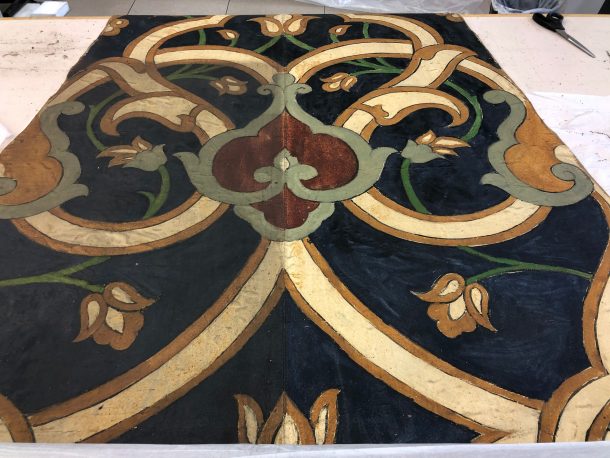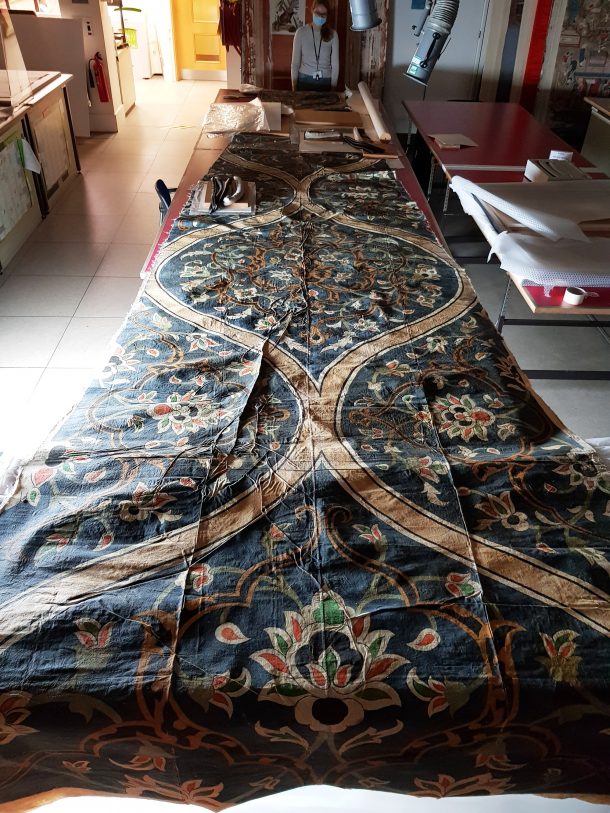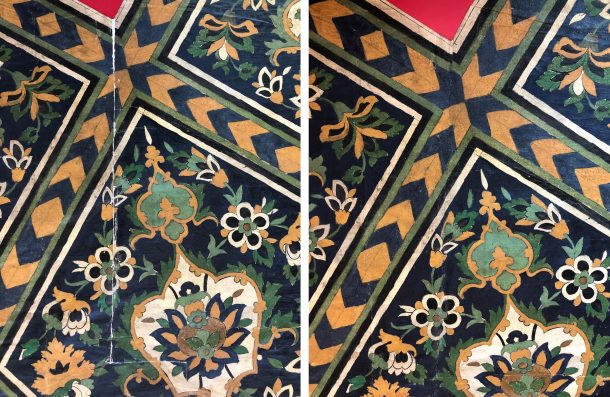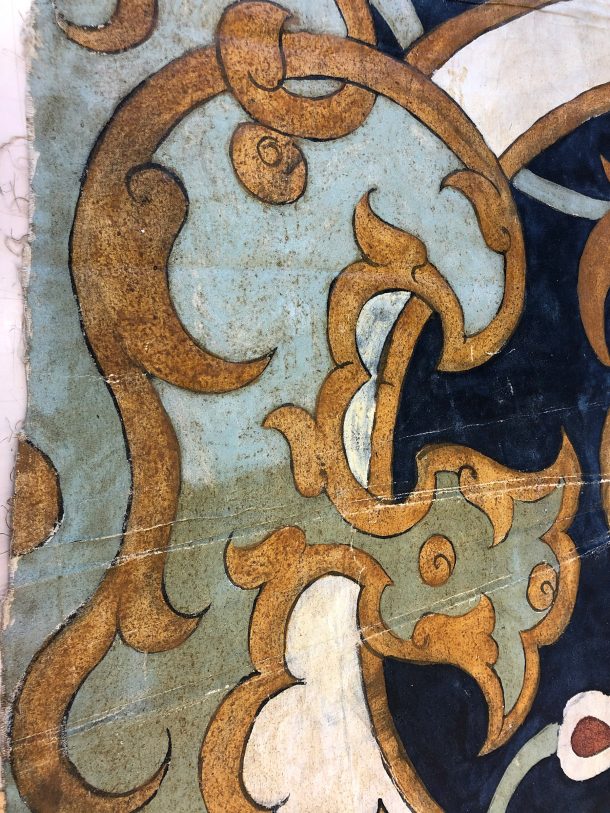by Alexandra Lawson, Paintings Conservator
In preparation for the 2021 Epic Iran exhibition, a team of four paintings conservators worked on four unstretched painted canvases that were commissioned in 1877 to record parts of the tile decoration in four different monuments in Isfahan. Three of the four paintings are triangular canvases, or gores, each over 10 metres long, narrow segments which nevertheless capture all the elements of the decoration of the dome interiors: the Mosque of Sheikh Lutfallah completed in 1619 (646-1878), the Mosque of the Shah completed in 1631 (633-1878), and the Mosque of the Sayyid begun in 1829 (645-1878). The fourth canvas records a section of the exterior of the Madrasah of the Mother of the Shah, dating from 1704-1710 (668-1878). It is a rectangular format, with a serrated top edge that indicates the transition between the wall and a complex vault.
The paintings are executed in oil on canvas, with pigment analysis showing the artists used ultramarine, carbon black, red lead, emerald green and lead white. In some areas we saw evidence of graphite underdrawing, which elsewhere was covered by black painted lines that formed part of the design. Some variations in the order of painting between the canvases were observed, perhaps indicating different artists. In one gore the black painted outlines are frequently covered by other colours, whereas in the other works the black lines are applied later in the painting process.

The paintings were examined by curators and conservators in 2010 prior to their move to the Blythe House store and their history was traced by Dr Moya Carey in her 2017 publication Persian Art: Collecting the Arts of Iran in the Nineteenth Century. There is some physical evidence that they have been previously displayed: one painting has been lined and a batten attached, and all have substantial surface dirt (Figure 1). The main conservation focus of this project was to carry out structural work to make the paintings safe for display.
All the paintings are made up of several pieces of canvas, sewn together prior to painting. In the case of the triangular canvases, some deformations are likely inherent to the making of the object, as the canvas was distorted on either side of the central seam causing undulations. The paintings had been stored on rollers for some time, and deformations in the canvases had become compressed, resulting in sharp creases with lines of weakness and tears in the canvas with associated paint loss (Figure 2).

It was necessary to combine consolidation of fragile paint layers with whole-scale moisture treatment to reduce the creases where possible. Large sheets of GORE-TEX fabric with capillary matting were used to humidify the canvas, which was then manipulated and left under weight. Because the creases were often complex and very large, it was at times necessary to work on very large areas at a time, working in a team to manipulate the canvas before the moisture evaporated. It was then possible to mend the tears using polyamide welding powder from the reverse, with the additional application of a thin polyester mesh fabric (Stabiltex), coated with Lascaux heat seal adhesive 375, to reinforce the mends (Figure 3).

Two of the unlined gores had a very noticeable patchy discoloured varnish coating that disrupted the continuity of the tile patterns. This coating proved insoluble in all free solvents, but with extensive testing we were able to find a varnish removal method. After the paint surface had been dry cleaned using smoke sponge, a waxy coating was removed using white spirit. This was followed by an aqueous gel cleaning method with a low percentage of benzyl alcohol applied to the surface. Using this method increased the contact time the cleaning solution had with the varnish layer, and it was also possible to tailor the pH and add a chelating agent to remove the varnish more effectively (Figure 4). A final solvent mixture was applied to remove the varnish residue.

One of the biggest challenges of the treatment was the sheer scale of the objects, which meant that we were unable to unroll the paintings in their entirety within the conservation studios. Instead we worked on sections at a time and had to roll and unroll the canvases to reach different areas and work on the front and back. It was not until the later stages of the project that the paintings were unrolled in the Raphael Cartoon Court and we were able to see the objects fully for the first time since their treatment. We made templates from sheets of Tyvek and also took the opportunity to carry out some retouching using QoR watercolours.
The paintings also presented interesting challenges in their installation, where the gores will be displayed on curved mounts suspended from the ceiling in the shape of a dome. It was decided to hold the canvases in position using magnets rather than applying a strip lining or temporary tabs. As the works will be hanging from the narrow tip of their triangular shape and largely upside down, the advantage of the magnets is their ability to provide support across the whole object, rather than being restricted to the edges.
The mounts, designed by Factory Settings, consist of an aluminium framework with a 1mm powder-coated steel surface. A Tyvek template will act as a barrier between the canvas and the mount. Over 300 magnets per object were covered with Japanese paper toned with dilute acrylic paint to match the colours of the paintings.
The scale of the objects presented unique challenges in their conservation, as did the unusual nature of their display. At the time of writing the paintings are being installed in the Epic Iran exhibition ready for a new audience.
Acknowledgements
I am grateful to fellow paintings conservators on the project, Nicola Costaras, Nina Jiménez Gray and Sophie Reddington and to the curator, Tim Stanley for giving me the historical context. Thanks to Paper Conservation for letting us use the large tables in their studio and Textile Conservation for invaluable advice on magnets and helping to prepare Tyvek for the templates.
Epic Iran is organised by the V&A with the Iran Heritage Foundation in association with The Sarikhani Collection.
The exhibition is generously supported by The Godwin Family, Darioush Winery, Cockayne – Grants for the Arts, a donor-advised fund of The London Community Foundation, The Ruddock Foundation for the Arts, The Soudavar Memorial Foundation, The Arah Foundation and Dr Amir Ali Farman-Farma.



Excellent blog post . Had no idea the tiles had such a interesting history. Brilliant blog post :)
It was fascinating watching the work of preparing them for exhibit. I don’t understand the exact provenance though. Is it known under what authority they’re painted?